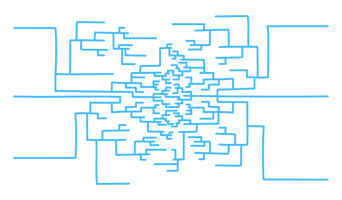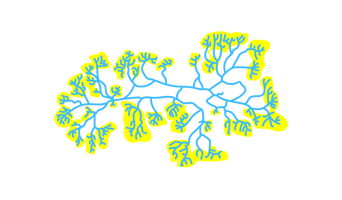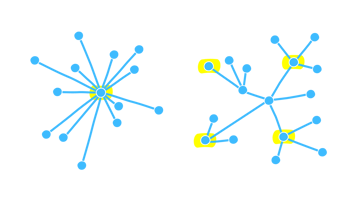How do you replace oversight systems based on managerial hierarchy with decentralized governance systems, in order to support higher levels of self-organization? In this blog post we discuss four questions to guide the journey towards decentralized set-ups.
When building a decentralized organization design, there are four key perspectives on shared oversight and control:
-
Which decentralized controls are required?
-
What form should these controls take in decentralized governance?
-
How do these controls come into being in a decentralized system, and how are they maintained?
-
How are these controls enforced, and how is decentralized power executed in an impactful way?
1. Which decentralized controls are required?
Decentralized control means that an organization has distributed mechanisms and processes in place that effectively enable an organization-wide control function to operate without (necessarily) relying on a managerial hierarchy and cascades of authority.
Moving to a decentralized organization design may imply that certain controls that had previously been part of the reporting relationship between boss and subordinates are no longer required. For example, if a decentralized model gives full authority over work execution to (former) subordinates, the according oversight form a boss might become largely irrelevant.
The following two criteria might serve to identify areas of control and oversight that will – one way or the other – still be required and will need to be empowered via a decentralized governance:
-
Core functions that are required for a system’s stability and viability: key actors within a system and key external stakeholders need transparent reassurance that core functions are fulfilled and viable. Think of key financials, such as liquidity management in a financial institution. But also think of non-negotiable regulatory requirements, e.g., in pharma.
-
Indispensable performance dimensions that support the value creation model of an institution, e.g., key indicators relating to production, supply chain, customer service, etc.
These functions must be controlled and reported on, regardless of the domain and scope of decentralized decision-making granted to self-managing roles by the governance.
Self-management models count on the feasibility of governance approaches that do not rely, or rely much less, on managerial authority and power-based and permanent reporting relationships in order to function.
2. What form should these controls take in decentralized governance?
Self-management is not black-and-white. Within an organization where there is division of work, there will be – and must be – some commitment to processes and interactions that are not fully within an individual’s control.
A first approach to organizational-level controls that respects decentralization is to clearly define and formalize the scope of decentralized authority (for authorized decision-making) that self-managed actors have in their roles. This decentralized authority must not be limited or generally conditioned by the power of a direct superior. However, there can be system-level requirements that any role must meet, as well as reporting and notification requirements.
These controls can then take the form of:
-
self-control based on clear guidance of what and how to observe;
-
mutual or peer-based control that is clearly limited in its purpose or scope;
-
input controls, e.g., in the form of people selection or standardization of tools and working methods;
-
output controls, like performance indicators or criteria-based evaluations.
None of these necessarily require a “boss” to implement and enforce them.
3. How do these controls come into being in a decentralized system, and how are they maintained?
Pure and absolute self-management is neither sensible nor possible when part of a larger system committed to the division of work in pursuit of shared goals.
In a traditional hierarchy, the organization’s board and executive committee play the key role in defining internal organizational rules and guidelines that govern controls.
When moving towards self-management, these rules and guidelines will typically be transferred to and adopted in a new set-up during the transition. Depending on the set-up, some form of “senior” committee might retain responsibility for maintaining the guidelines, for example ensuring their ongoing appropriateness in the light of evolving (external, legal) requirements. This could be the existing board, if self-management is formally confined in scope, e.g., to the execution of frontline work, and an increased level of decentralization is combined with a more classically shaped and governed superstructure.
In the absence of a unified chain of command of managerial hierarchy, such a committee and its outputs can be governed in a bottom-up way based on dedicated structures. This could include democratic elements, representative elements, or consultative elements.
4. How are these controls enforced, and how is decentralized power executed in an impactful way?
Good governance within decentralized systems cannot rely on a unified chain of command and bosses and middle managers overseeing, controlling, and correcting their subordinates along central guidelines.
A first step towards impactful governance is formalization of procedures. This formalization serves to make the steps, outputs, and impact of controls independent of a middle manager wielding power within their reporting relationships. Enforcing controls through formalized procedures can be assumed by a differentiated leadership function or an independent, audit-style function.
Within the logic of a “three lines of defense” risk management model, the first line of defense – “management controls” –must take a different shape, whereas the second and third lines of defense suit a decentralized model well.
Finally, an important informal element of performative decentralized controls is culture – that is the behaviors that influence the effectiveness of controls and compliance. Arguably, the presence of micromanaging bosses might do more harm than good when it comes to supporting compliant behaviors. Granting decentralized authority may in fact increase compliant, responsible behavior, without strong (manager-led) incentives working towards the contrary.
Work with our Organize for Self-Management Kit to define your levels of self-management along key management functions.



